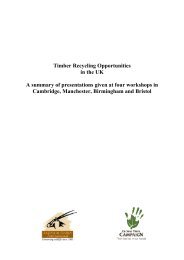Estado y aprovechamiento sostenible de la caoba en Centroamérica
Estado y aprovechamiento sostenible de la caoba en Centroamérica
Estado y aprovechamiento sostenible de la caoba en Centroamérica
Create successful ePaper yourself
Turn your PDF publications into a flip-book with our unique Google optimized e-Paper software.
Tab<strong>la</strong> 11: Volum<strong>en</strong> autorizado <strong>de</strong> <strong>caoba</strong> por <strong>de</strong>partam<strong>en</strong>to <strong>en</strong> Nicaragua (m 3 ssc)<br />
Año Jinotega Matagalpa RSJuan Ze<strong>la</strong>ya* RAAN RAAS Total<br />
nacional<br />
1981 391 123 91 5.041 - - 6.243<br />
1984 29 182 934 2.588 - - 4.220<br />
1985 0 - 292 3.198 - - 3.910<br />
1997 - - 437 - - - -<br />
1998 60 15 171 2.525 - - 2.869<br />
1999 - - - - - - -<br />
2000 - - - - 2.425 1.887 4.292<br />
2001 - - 5 - 2.637 935 3.572<br />
2002 - - - - 4.610 9.426 14.106<br />
2003 - - 5 - 6.513 17.826 24.339<br />
* El antiguo dpto <strong>de</strong> Ze<strong>la</strong>ya agrupaba los actuales <strong>de</strong>partam<strong>en</strong>tos <strong>de</strong> RAAN y RAAS.<br />
ssc: rollo sólido sin corteza<br />
Fu<strong>en</strong>te: anuarios estadísticos <strong>de</strong> IRENA 1977-84, Servicio Forestal Nacional 1998-99,<br />
SIRCOF/INAFOR 1998-2003<br />
Tab<strong>la</strong> 12: Volum<strong>en</strong> <strong>de</strong> <strong>caoba</strong> aprovechado <strong>en</strong> Nicaragua <strong>en</strong> p<strong>la</strong>nes g<strong>en</strong>erales <strong>de</strong> manejo<br />
forestal (PGMF) y p<strong>la</strong>nes mínimos <strong>de</strong> manejo (PM) <strong>en</strong> el periodo 2000-2003<br />
Dpto/Municipio 2000 2001 2002 2003 Total<br />
PGMF PM PGMF PM (m 3 ssc)<br />
RAAN (total) 2.425 2.637 4.259 351 3.371 3.142 16.185<br />
Prinzapolka 2.215 2.111 1.242 n. d. 745 n. d. 6.313<br />
Puerto Cabezas 210 172 813 - 631 1.206 3.032<br />
Rosita - - 1.993 n. d. 4 n. d. 1.997<br />
Siuna - 354 55 n. d. 119 n. d. 528<br />
Waspán - - 156 351 1.872 1.936 4.315<br />
RAAS (total) 1.867 935 4.049 5.447 7.547 10.279 30.124<br />
Cruz Río Gran<strong>de</strong> 1.867 228 810 3.167 6.978 7.538 20.588<br />
Desemb. RG<strong>de</strong> - - - - 396 695 1.091<br />
Kubra Hill - - 1.928 99 - 287 2.314<br />
El Tortuguero - 235 1.311 1.914 - 1.212 4.672<br />
Laguna Per<strong>la</strong>s - 472 - 267 173 547 1.459<br />
RÍO SAN JUAN (total) - 5 - - 5 - 10<br />
San Miguelito - - - - 5 - 5<br />
El Castillo - 5 - - - - 5<br />
Gran total (m3 ) 4.292 3.572 8.308 5.798 10.918 13.421 46.311<br />
ssc: rollo sólido sin corteza<br />
n. d.: datos no disponibles<br />
Fu<strong>en</strong>te: SIRCOF/INAFOR 2004, Registros Distritos Forestales I y IX<br />
Estudio <strong>de</strong> diagnóstico <strong>en</strong> Nicaragua<br />
mi<strong>en</strong>tos ilegales y evadir <strong>la</strong>s responsabilida<strong>de</strong>s<br />
técnicas y administrativas que exig<strong>en</strong> los p<strong>la</strong>nes<br />
g<strong>en</strong>erales <strong>de</strong> manejo. Este tipo <strong>de</strong> p<strong>la</strong>n mínimo da<br />
lugar a varias formas <strong>de</strong> <strong>aprovechami<strong>en</strong>to</strong> ilegal y<br />
fraudul<strong>en</strong>to: solicitar un permiso para áreas muy<br />
pequeñas y <strong>de</strong>jar áreas <strong>en</strong> <strong>la</strong> misma finca para<br />
extraer ma<strong>de</strong>ra adicional, o sobreestimar durante<br />
el c<strong>en</strong>so comercial <strong>la</strong>s exist<strong>en</strong>cias <strong>de</strong> volum<strong>en</strong> <strong>de</strong><br />
ma<strong>de</strong>ra para el área solicitada. Se estima según<br />
estas fu<strong>en</strong>tes que el porc<strong>en</strong>taje <strong>de</strong> <strong>aprovechami<strong>en</strong>to</strong><br />
<strong>de</strong> ma<strong>de</strong>ra ilegal bajo el amparo <strong>de</strong> los<br />
p<strong>la</strong>nes mínimos es <strong>de</strong> un 50% <strong>de</strong> lo autorizado<br />
como mínimo (Ampié 2002, Paniagua 2002).<br />
De acuerdo con datos registrados para los años<br />
2002 al 2004, <strong>en</strong> <strong>la</strong> RAAN se autorizaron 57<br />
p<strong>la</strong>nes mínimos <strong>en</strong> los municipios <strong>de</strong> Waspán y<br />
Puerto Cabezas para un volum<strong>en</strong> total <strong>de</strong><br />
6.965 m3 . En cambio <strong>en</strong> <strong>la</strong> RAAS se autorizaron<br />
107 p<strong>la</strong>nes mínimos con un volum<strong>en</strong> total <strong>de</strong><br />
24.203 m3 , ubicándose el 85% <strong>en</strong> sólo dos<br />
municipios: La Cruz <strong>de</strong>l Río Gran<strong>de</strong> y Tortuguero.<br />
T<strong>en</strong>i<strong>en</strong>do <strong>en</strong> cu<strong>en</strong>ta que el área máxima autorizada<br />
para este tipo <strong>de</strong> p<strong>la</strong>nes es <strong>de</strong> 50 ha,<br />
estas cifras indican que <strong>en</strong> <strong>la</strong> RAAN <strong>la</strong> exist<strong>en</strong>cia<br />
<strong>de</strong> <strong>caoba</strong> <strong>en</strong> volum<strong>en</strong> promedio por hectárea<br />
es <strong>de</strong> 2,4 m3 /ha, mi<strong>en</strong>tras que <strong>en</strong> <strong>la</strong> RAAS es<br />
<strong>de</strong> 4,5 m3 /ha. Al comparar esta cifras con <strong>la</strong>s<br />
exist<strong>en</strong>cias volumétricas <strong>de</strong> <strong>caoba</strong> <strong>en</strong> inv<strong>en</strong>tarios<br />
y p<strong>la</strong>nes g<strong>en</strong>erales <strong>de</strong> manejo <strong>en</strong> superficies<br />
más ext<strong>en</strong>sas, que son <strong>de</strong>l or<strong>de</strong>n <strong>de</strong> 0,57 m3 /ha<br />
<strong>en</strong> <strong>la</strong> RAAS y 1,0 m3 /ha <strong>en</strong> <strong>la</strong> RAAN, se pue<strong>de</strong><br />
concluir que dichas cifras están bastante<br />
abultadas, corroborando lo expresado <strong>en</strong> los<br />
párrafos previos.<br />
Las pérdidas económicas <strong>de</strong>rivadas <strong>de</strong> estas<br />
activida<strong>de</strong>s ilegales y no contro<strong>la</strong>das son<br />
cuantiosas (Richards et al. 2003) y no sólo <strong>en</strong><br />
términos monetarios sino <strong>en</strong> términos económicos<br />
afectando al resto <strong>de</strong> <strong>la</strong> sociedad que no<br />
está directam<strong>en</strong>te re<strong>la</strong>cionada con <strong>la</strong> actividad<br />
forestal. Por ejemplo, según datos <strong>de</strong>l año 2001<br />
el valor <strong>de</strong> <strong>la</strong> ma<strong>de</strong>ra cortada ilegalm<strong>en</strong>te se<br />
estima <strong>en</strong>tre 10 y 17 millones <strong>de</strong> dó<strong>la</strong>res, <strong>de</strong> los<br />
cuales ni el estado ni <strong>la</strong>s municipalida<strong>de</strong>s<br />
percibieron impuestos. También hay costos <strong>de</strong><br />
oportunidad re<strong>la</strong>cionados con el <strong>de</strong>sperdicio <strong>de</strong>l<br />
gasto público y fondos <strong>de</strong> donantes interesados<br />
19




